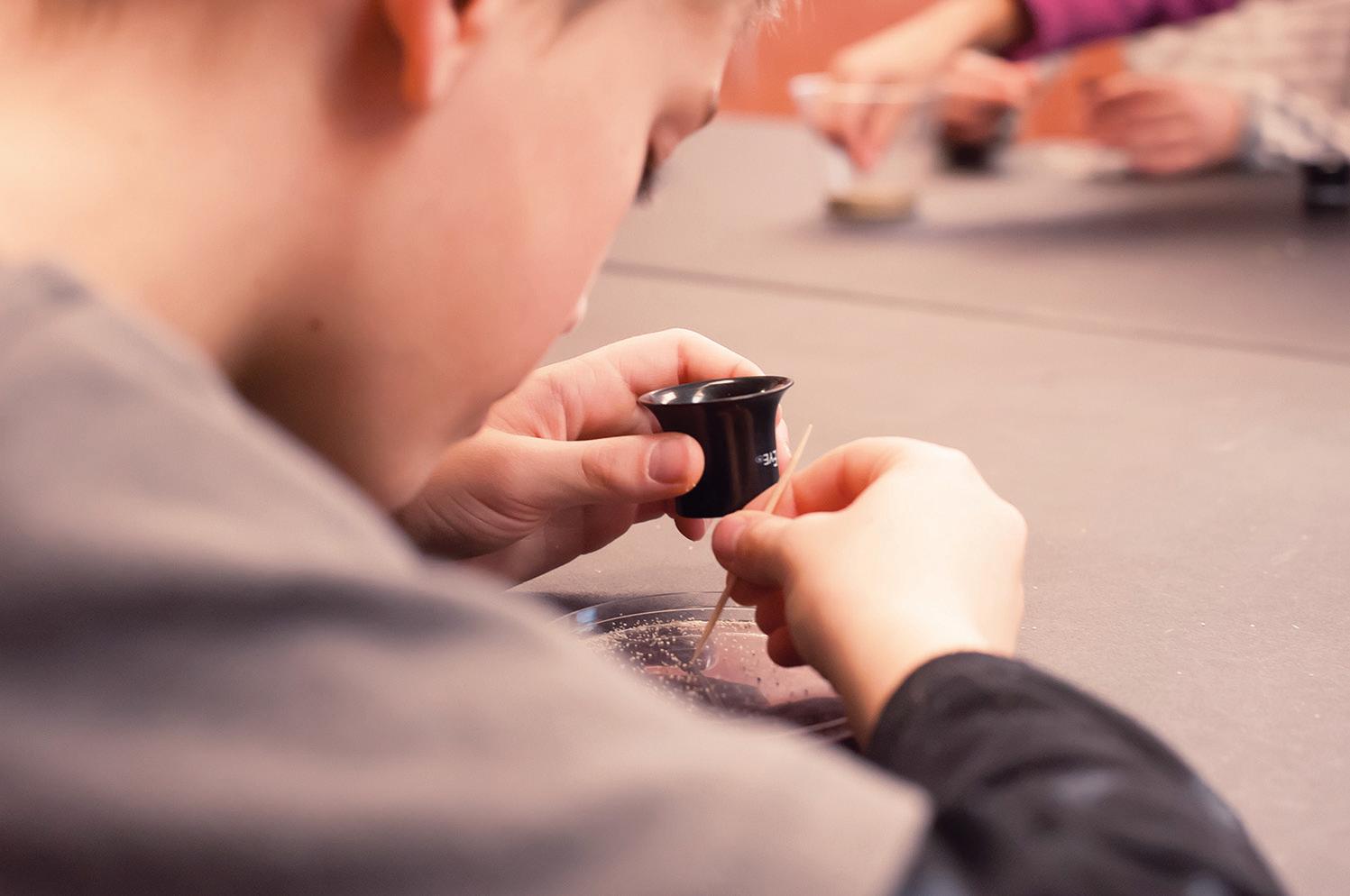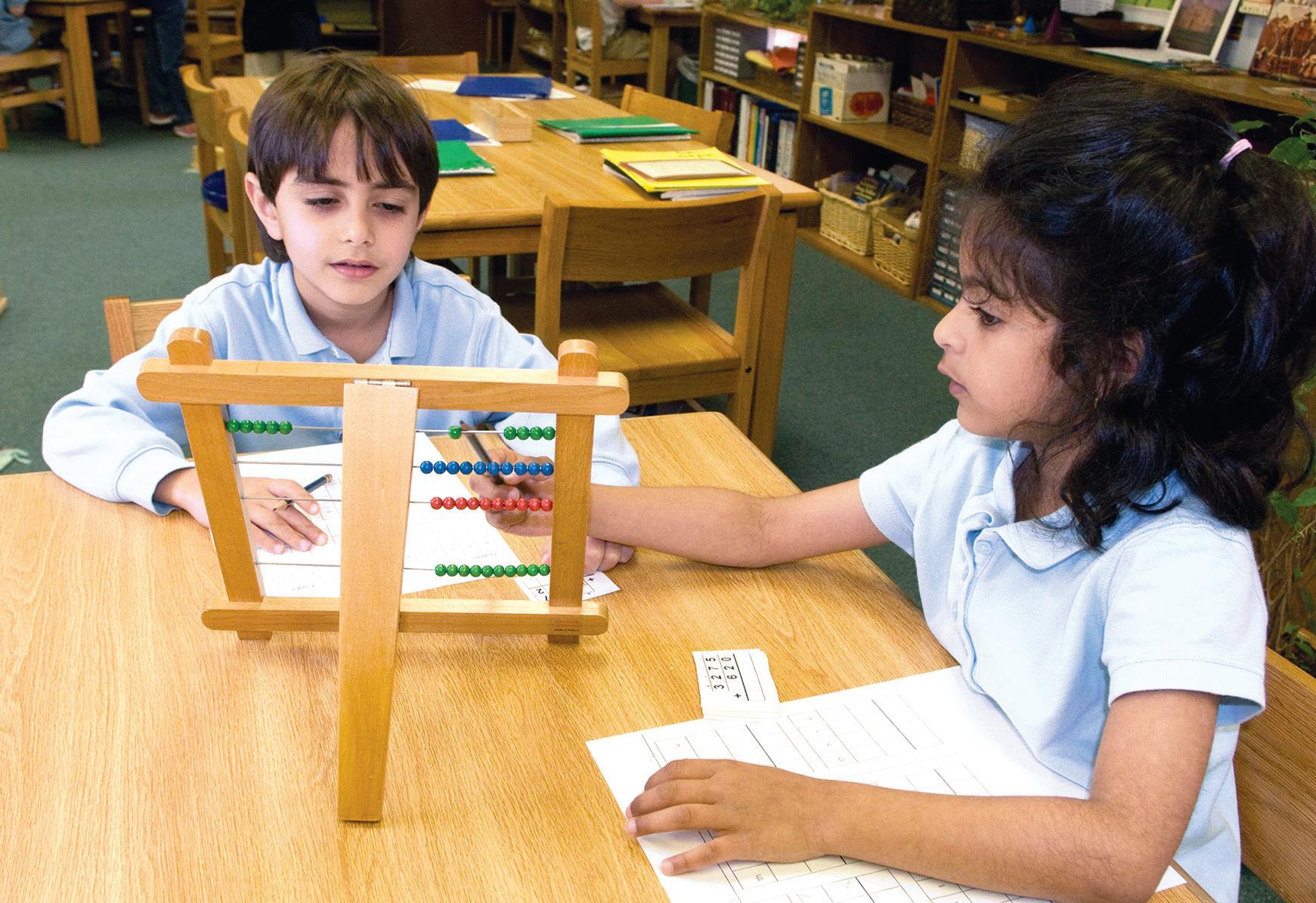
6 minute read
Montessori Math: From the Concrete to the Abstract
Students who learn math by rote often have no real understanding or ability to put their skills to use in everyday life. Learning comes much more easily when they work with concrete educational materials that graphically show what is taking place in a given mathematical process.
ontessori students use handson learning materials that make abstract concepts clear and concrete. ey can literally see and explore what is going on. is approach to teaching mathematics, based on the research of Drs. Maria and Mario Montessori, o ers a clear and logical strategy for helping students understand and develop a sound foundation in mathematics and geometry.
e Montessori math curriculum is based on the European tradition of uni ed math, which has only recently begun to be incorporated into the American math curriculum.
Uni ed Math introduces elementary students to the study of the fundamentals of algebra, geometry, logic, and statistics along with the principles of arithmetic. is study continues over the years, weaving together subjects that traditional schools normally ignore until the secondary grades.
e concrete Montessori math materials are perhaps the best known and most imitated elements of Dr. Montessori’s work. ese elegant and simply lovely materials hold a fascination for most children and adults alike.
ey proceed through several levels of abstraction, beginning with concepts and skills that are the most basic foundations of mathematics, presented in the most concrete representation, up through the advanced concepts of secondary mathematics, which are represented in increasing levels of abstraction, until the student grasps them conceptually.


The Red & Blue Rods
The Spindle Boxes
left The Red and Blue Rods are the child’s introduction to mathematics. These rods have the same dimensions as the Red Rods found in the Sensorial area. Here, however, the rods are painted in alternating patterns of red and blue to distinguish their length in segments of one tenth of a meter (a decimeter). The fi rst rod is one decimeter long and is just painted red. The second is two decimeters long, and is divided into two segments, one red and one blue. This continues through all ten rods.
As with the Red Rods, the children arrange the Red and Blue Number Rods into a stair from largest to smallest. Then they count each alternating colored segment. One of the insights that children begin to get from working with the rods is the nature of addition. For example, when the children place the “one” number rod at the end of the “two” rod, they create a new rod that is the same length as the “three” rod just above. They explore similar relationships with all of the numbers 1 to 10. For example, they discover that the “four” and the “six” together are the same length as the “ten.”
Montessori found that young children fi nd it diffi cult in the beginning to grasp the concept of numbers by counting separate objects. While they can learn to “count” by rote, reciting the sequence of numbers from one to ten, most cannot easily grasp the difference between one quantity and another when looking at more than three or four objects. It’s almost as if they are thinking: “One, two, three... Many!” This is easily avoided by allowing children to visualize the concept of numbers and quantity by using this series of segmented rods of increasing length in the beginning, rather than trying to teach them to count sets of separate objects. The children also use the sandpaper numeral cards to label each number rod. These tablets are designed and used in the same way as the Sandpaper Letters described in the section on Language Arts.
above Provide a nicely structured way for young children to make the next step in understanding the concepts of numbers and quantity. The material is made up of two wooden boxes, which together are divided into ten compartments. The compartments are labeled with the numerals from zero through nine. In a separate box or basket are forty-fi ve wooden spindles used for counting. The exercise calls for the child to count the correct number of spindles to go in each compartment: one, two, three ... all the way to nine. Naturally, the compartment labeled “zero” is left empty, teaching the child at a very early age the concept of zero as an empty set. If the child has counted correctly, there will not be any spindles left over when he fi lls up the compartment labeled “nine.” One lovely variation of this activity challenges the young child to create a distinct set for each number, while practicing bow-tying skills by tying a green ribbon (green symbolizes the concept of units - whole numbers less than ten) around the clustered spindles. Then this bundle is placed in the correct compartment.
MONTESSORI MATH
The Numeral Cards & Counters
above After considerable experience with the more structured introductions to number and quantity created by the Red and Blue Number Rods and the Spindle Boxes, children are fi nally ready to tackle the task of associating cards on which the numerals have been printed with objects to count. They begin by arranging the numeral cards in order from one to ten. Then they begin to count out the appropriate number of counters, placing them in parallel rows of two after the number one. Even numbers end with an even number of counters in the bottom row; odd numbers only have one. This begins to focus their attention on the concept of odd and even numbers.

The Golden Beads:
An Introduction to the Decimal System
right Dr. Montessori developed a wonderful educational material called the Golden Beads to illustrate concretely the nature of place value in the decimal system and its basic operations. The name comes from the beautiful color used for the enamel fi nish on this set of small glass beads.

A single bead by itself represents a unit of one. Thus, the number 5 would be represented by a collection of fi ve “unit” beads. Ten “unit” beads strung together on a length of wire represents a unit of ten. Three “10” bars collected together actually consists of thirty “unit” beads, or three “10s.” The children quickly discover that ten “unit” beads are exactly the same as one “10” bar. They also begin to count not only the individual “unit” beads but by units of ten: 10, 20, 30 ... 100.
Ten “10” bead bars naturally equal the quantity of one hundred. Units of one hundred are made up of ten “10” bead bars laid side by side and wired together to form a square. Ten “100” squares stacked one on top of the other form a cube containing one thousand “unit” beads. They are permanently wired together to form the thousand cube. Using these concrete materials, even very young children can build and work with great numbers. In a typical early lesson with the Golden Beads, the teacher might challenge the child to, “Bring me three ‘1,000s,’ fi ve ‘100s,’ six ‘10s,’ and one ‘unit.’” While they will also work with prepared problem cards, children often enjoy thinking up numbers for themselves. The Numeral Cards & Golden Beads
above The Numeral Cards and Golden Beads This special set of numeral cards is used to help the children learn to read numerals up to 9,999. Used to label the units, tens, hundreds, and thousands in which the Golden Beads are laid out, they help children begin to understand the concept of the hierarchy of the decimal quantities and how we borrow and carry from the next column in mathematical operations. The large size of the cards and the color coding used to represent units, tens, hundreds, and thousands makes it easy for children to understand how large quantities are constructed from right to left, read from left to right, and worked within vertical columns. The children shown above are using the Golden Beads and Numeral Cards to add two quantities: 3,542 + 4,145 = 7,687.










